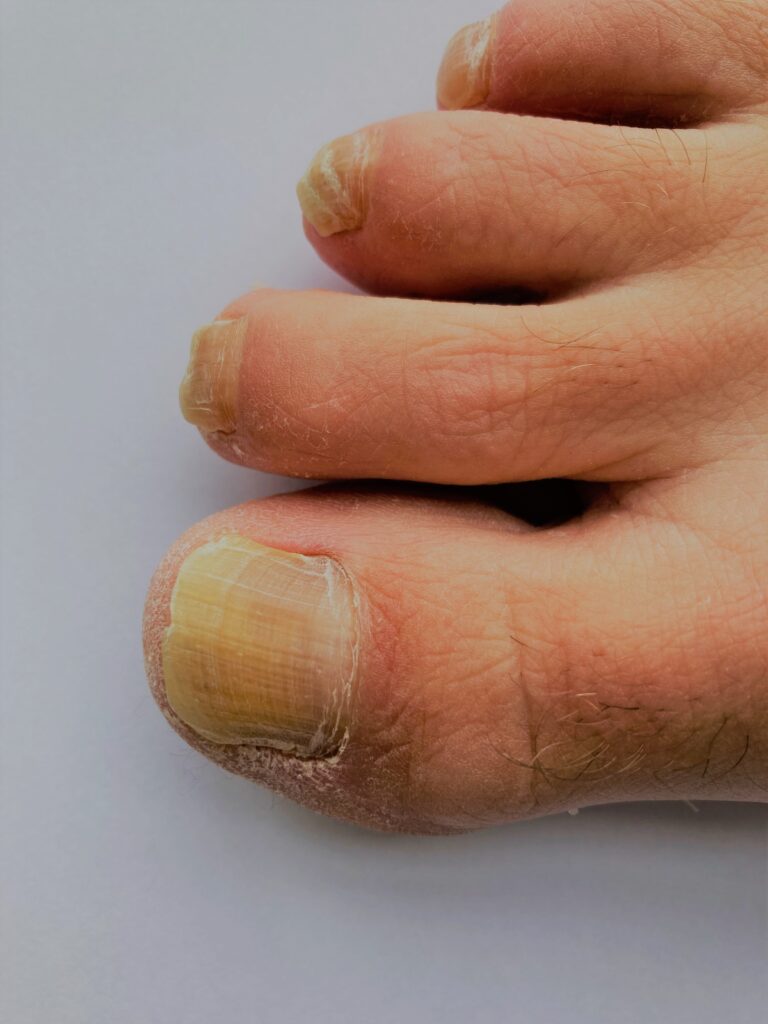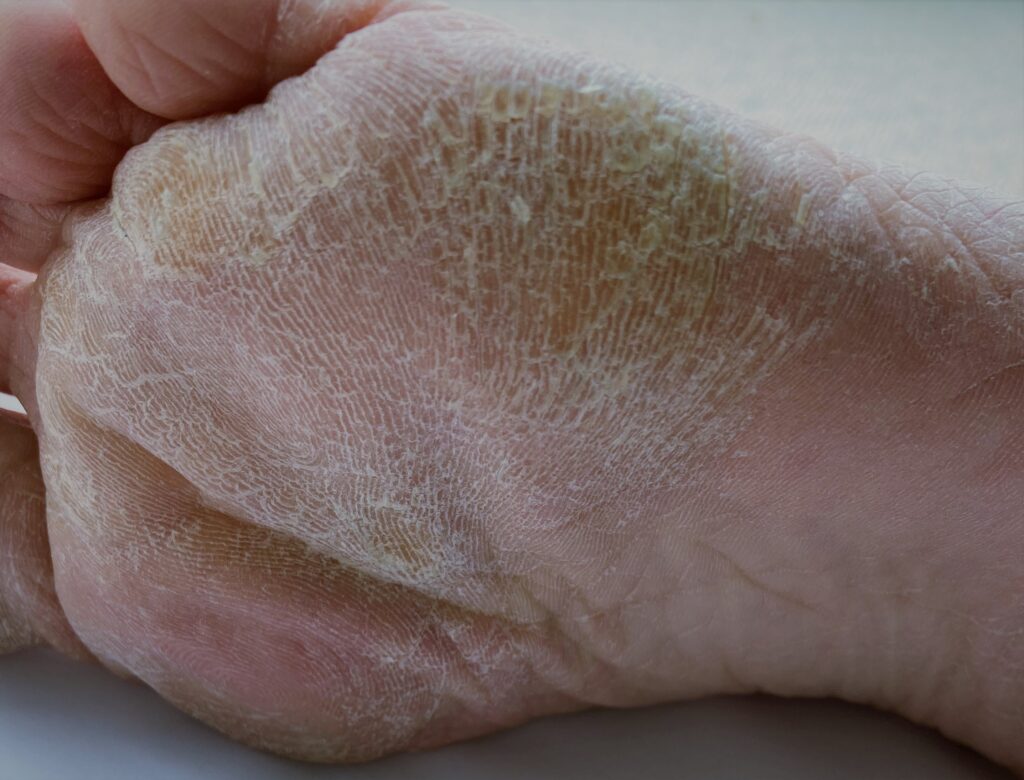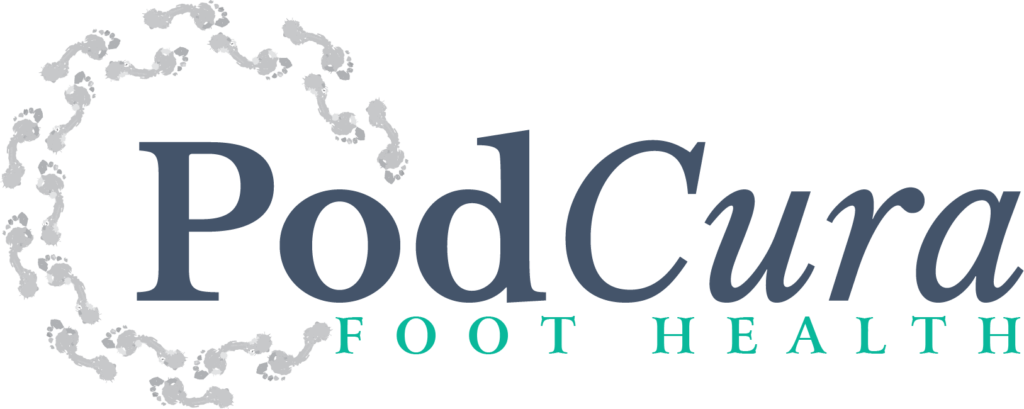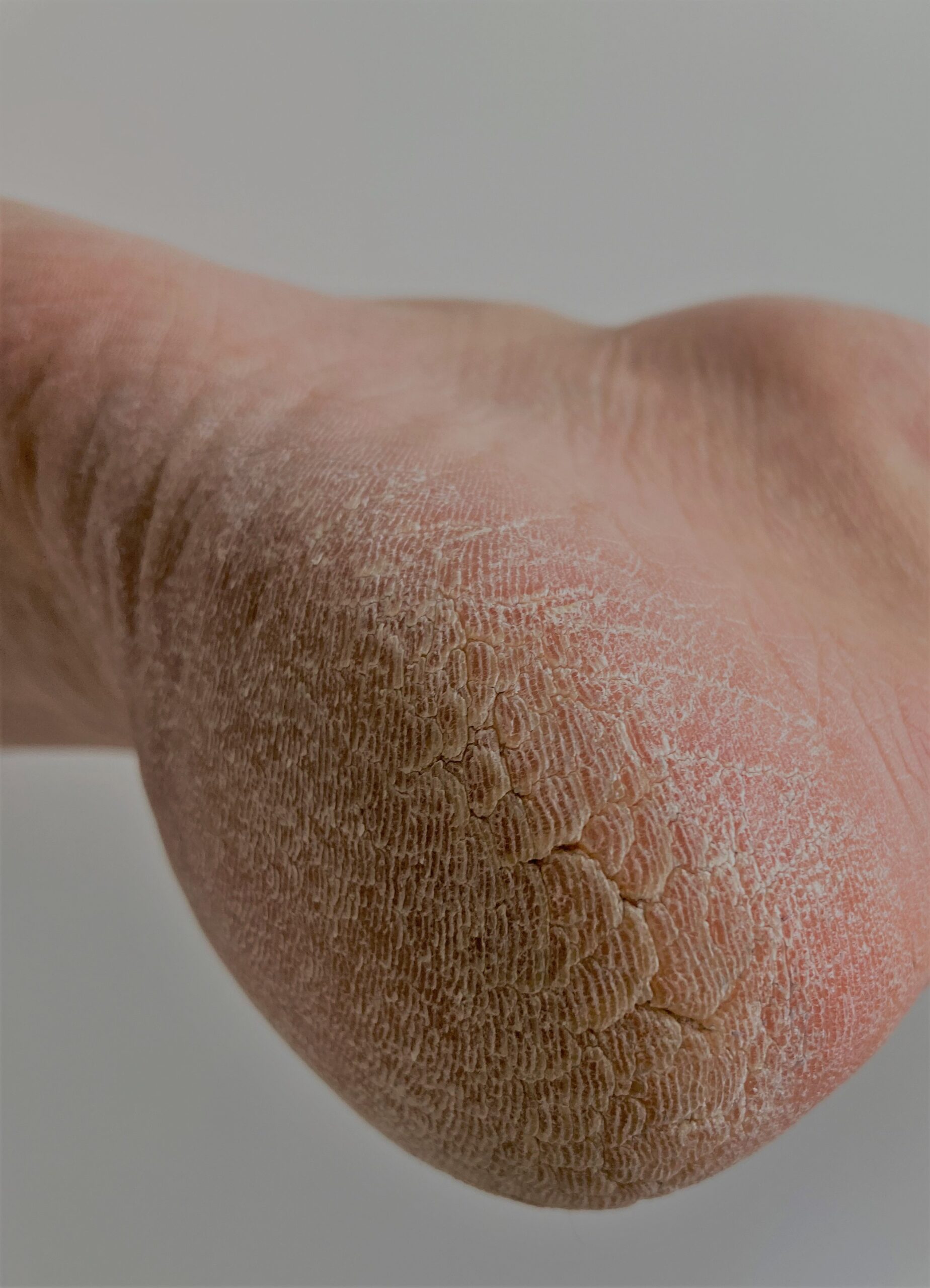Conditions of the foot
Heels carry the weight of your body whenever you are standing, so when they lack moisture and dry skin builds up, cracked heels can develop.
After clinical treatment, regular use of moisturising products can help prevent cracked heels from returning. We stock a wide range of specialist creams in our clinic and can advise you on the best creams for you.
Nail thickening can happen as part of ageing, or because of trauma but the issue can also be a result of an underlying fungal infection. Some of the common symptoms you will find alongside thickened nails include:
- Colour changes in the nail
- Nails lifting from the nail bed
- Nails are crumbly
- Pain or discomfort around the nails
Fungal nail treatments provided in the clinic involve an assessment of your general well-being and foot health before deciding on a treatment plan, as no one treatment suits or works for all.
Thickened nails can also be difficult to cut, which can lead to pain and other problems. At our clinic, we have special nail trimmers to accommodate thickened nails, or we can thin such nails with a small electric file. During treatment, your skin is also checked, and rich foot cream is applied at the end of the treatment.

Both corns and callus are caused by hard skin. Corns are usually smaller and more localised in their painful impact. Corns are commonly found on the toes (although they may be on other areas of the feet).
In contrast, a callus is a larger, often yellow plaque of hard skin, mostly found on the sole of the foot.
Some people have a natural tendency to form corns and callus because of their skin type or because of the way they walk.
Corns and callus build up is a painful problem that requires routine professional treatment. In the clinic we remove the corns and callus painlessly, before finishing your treatment with a rich foot cream and advice on how to slow down the return of corns and callus.

Blisters can become a more serious concern if you have diabetes as they may not heal.
Most foot blisters last between three and seven days and will normally clear up if further excessive friction is avoided.
Bunion, also known as ‘hallux valgus’, is a deformity of the big toe where the big toe excessively angles towards the second toe and leads to a bony lump on the side of the foot. This can also form a large sac of fluid, known as a bursa, which can then become inflamed and sore.
Tight or narrow footwear tends to aggravate the problem as they squeeze the forefoot, crowding the toes together and exacerbate the underlying condition, causing pain and deformity of the joint.
Once the big toe leans toward the second toe, the tendons no longer pull the toe in a straight line, so the problem tends to get progressively worse.
Only specialist surgery with a podiatric or orthopedic surgeon can remove bunions. Whilst we cannot remove bunions, we can offer advice and product suggestions to help cushion and protect the bunion from pressure, such as gel separators or special cushioning gel sleeves.
Verrucae are harmless but can be uncomfortable and painful if they develop on a weight bearing part of the foot. In addition, hard skin (callus) can form over the top of the verruca, increasing discomfort in this area. Verruca is caused by the Human Papilloma Virus. The most common appearance is that of a small cauliflower-type growth on the soles of your feet with tiny black dots.
Treatments provided involve an assessment of your general well-being and foot health before deciding on a management plan.
-
Athlete’s foot is a fungal infection of the skin that can lead to intense itching, cracked, blistered or peeling areas of skin, redness and scaling. It usually occurs between the fourth and fifth toes initially, or on dry, flaky skin around the heels or elsewhere on the foot.
The condition can also spread along all five toes and sometimes to the nails and soles of the feet if left untreated. Athlete's foot requires anti fungal treatment.
- Heel pain is usually either caused by some form of injury, lower back problem or inflammatory joint condition. There are often no visible features on the heel, instead there are localised, deep, painful spots found in or around the middle of the sole of the heel. Pain is usually worse on standing after long periods of rest, particularly first thing in the morning. There are several different types of heel pain;
- Plantar fasciitis (or fasciopathy): This is caused by damage to the fascia ‘band’ which connects the heel bone to the base of the toes. This condition can be caused in various ways including extensive running, walking or standing for long periods of time.
- Heel bursitis (subcalcaneal bursitis): This is an inflammation of a bursa (a fluid-filled fibrous sac) under the heel bone where the pain is typically more in the centre of the heel than that experienced with plantar fasciitis and significantly worsens during the day. This condition can be caused following a fall from a height on to the heel.
- Heel bumps: These are firm bumps on the back of the heel, usually caused by excessive shoe rubbing in the heel area, or the thickening of the tissues associated with a tight Achilles tendon.
- Tarsal tunnel syndrome: This can feel like a burning or tingling sensation under the heel within the arch of the foot with occasional loss of sensation on the bottom of the foot. This is caused by compression of the tibial nerve as it passes the inside of the ankle.
- Chronic inflammation of the heel pad: This is caused by a heavy heel strike or sometimes a reduction in the thickness of the heel pad, which can give rise to a dull ache in the heel which increases during the day.
- Achilles tendonosis: the Achilles tendon is placed under more pressure than it can cope with, causing small tears to develop along with inflammation and in some cases tendon rupture. These tears become a source of further injury, which can lead to swelling within the tendon.
- Pain in the ball of the foot (Metatarsalgia). Those with metatarsalgia experience pain and inflammation in the padding directly below the toes, where most pressure when standing and moving.The pain is usually present in the metatarsal heads — the joint that is just under your toes — or the big toe. You may also experience shooting pain, numbness, and pain with flexing the toes. The pain may ease when you are off your feet and return when you resume your normal activities. A person can develop metatarsalgia due to several factors, and it’s important to narrow down the cause in order to implement the best treatment.
- Arthritis is a disease of the joints, which causes them to become inflamed and stiffen. There are three types of arthritis – Rheumatoid arthritis, Osteoarthritis and Gout;
- Rheumatoid arthritis causes inflammation in many joints of the body, but particularly affects the hands, feet, wrists, ankles and knees. Symptoms include joint pain and stiffness, and muscle aches. The stiffness tends to be worse in the morning and after rest. The metatarsal-phalangeal joints are often affected (where the long bones of the feet meet the toes) and can result in hallux valgus (big toe angled excessively towards the second toe) and hammer toe deformities (toes curled in claw-like shape). Each of these deformities can cause further problems. If the joints in the middle of the foot are affected, the arch can collapse, leading to a flatfoot deformity and spreading of the forefoot. The fatty pads on the balls of the feet may slip forward, causing pain on the balls of the feet and backs of the toes. Alongside GP treatment, your foot health can be improved with special types of insole that can be fitted into your shoes. They will help you walk in such a way to minimise the pressure on your affected joints. Protective toe shields, padding and gel cushions can also help relieve pressure and reduce friction
- Osteoarthritis occurs when joint cartilage deteriorates, and the bone underneath thickens. This causes pain, stiffness and swelling. Osteoarthritis can affect any of the joints in the feet but mostly affects those at the base of the big toes. Minimise the stress on your joints by wearing well-cushioned shoes. Putting special insoles into your shoes can also help by redistributing pressure as you walk, helping to alleviate the pain in your joints.
- Gout is the result of an imbalance of uric acid in the body and manifests via a build-up of uric acid in the blood. Small crystals may form, which collect in the joint causing irritation and inflammation, and can be very painful. The main symptom of gout is acute throbbing pain and swelling in the big toe. Alongside GP treatment you can help by adapting your existing footwear with insoles which help redistribute pressure away from the affected parts.
- Diabetes, having diabetes means you are at much greater risk of developing foot problems. This is because raised blood glucose, also known as blood sugar, can damage the sensation in your feet. It can also affect your circulation, causing less blood supply to the feet. Without a good blood supply, healing can be limited and may lead to foot ulcers and infections. Most foot problems can be prevented with regular foot checks and care.

